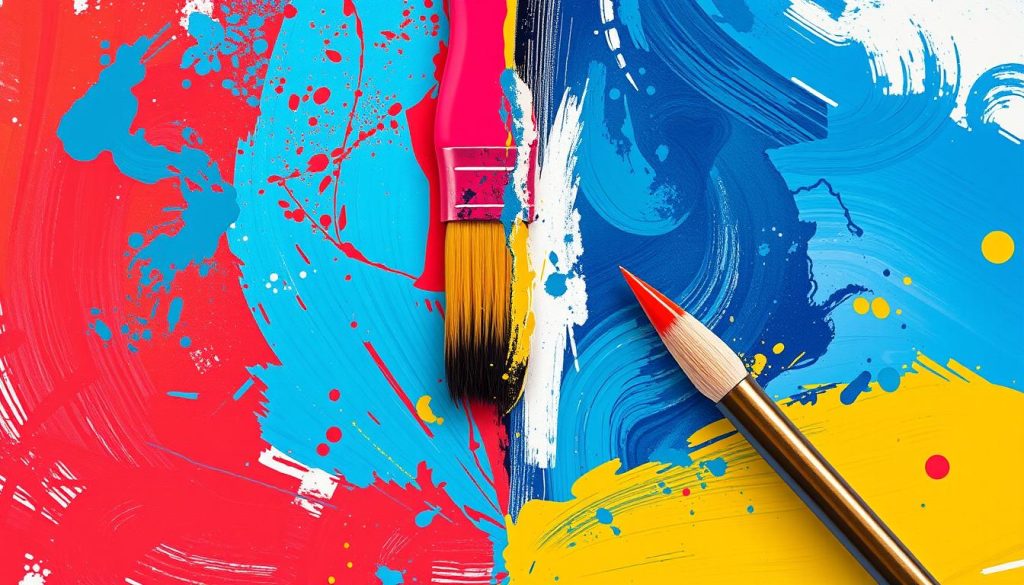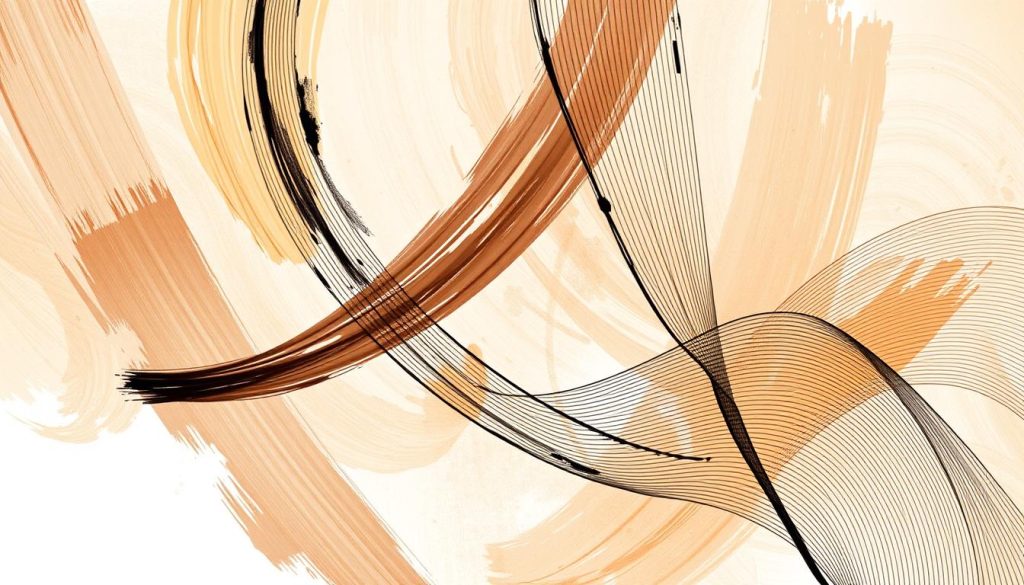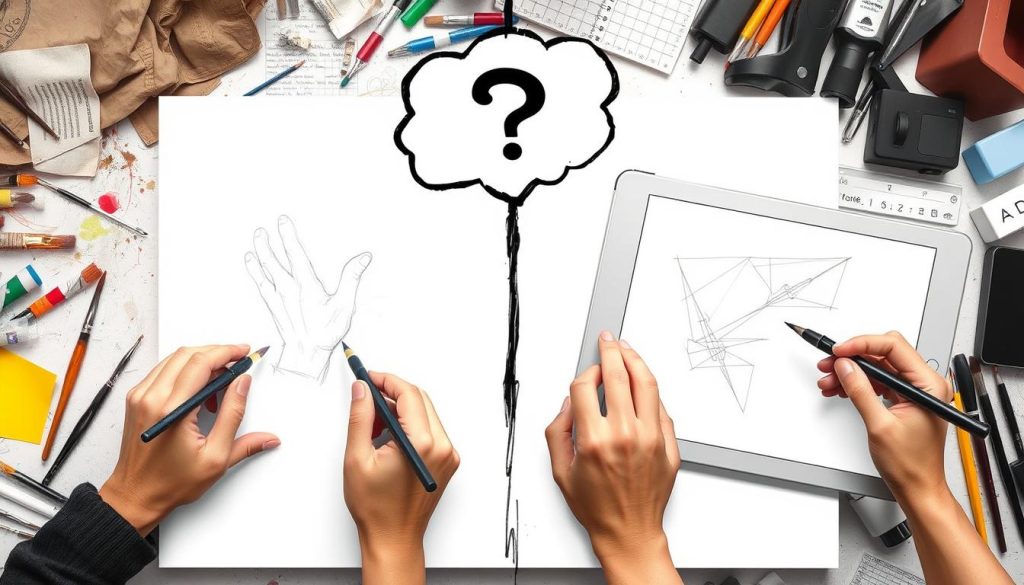In the world of art, we see a dance between traditional and digital art. Artists, fans, and creative people explore the unique traits of each. They look at how these arts can work together today.
Do you like the feel of painting on canvas or the endless options of digital art? This guide will help you understand and value both kinds of art more. We’ll look at what makes each special and how they share common goals in art.
We’ll dive into the histories, new techniques, and different ways traditional and digital art express themselves. This will show us the real heart of creating, enjoying, and experiencing art. Come with us as we explore this exciting world. Here, the lines between old and new art fade, and creativity reaches new peaks.
Unveiling the Timeless Appeal of Traditional Art
Traditional art has been loved for centuries. It connects us to the past in a special way. From oil paintings to sculptures, it offers a unique experience that digital art can’t match.
A Tangible Connection to History
Looking at traditional art, we connect with the artist and their time. We see the textures, imperfections, and variations. These make us appreciate the art more deeply.
The Charm of Physical Textures and Imperfections
Traditional art like painting, drawing, and sculpture shows the artist’s hand. This gives each piece its own charm. It invites us to see the details and feel the human touch.
“There is something special about the imperfections and variations in traditional art that digital can never replicate. It’s the human element that makes it so captivating.”
Traditional art lets us connect with history and stories passed down through time. This connection to the past is what makes it so special. It continues to inspire people all over the world.
Exploring the Cutting-Edge World of Digital Art

The digital art revolution has changed how we see art. Artists now use technology to make stunning and new works. They use digital painting, sculpture, and computer art to show their creativity.
Many artists now choose the digital canvas. They use special software and tools to make their art. This has made digital art very exciting and full of new ideas.
- Digital painting: Artists use digital drawing tablets, styluses, and software like Adobe Photoshop or Procreate to create vibrant, layered digital paintings that mimic the look and feel of traditional media.
- Digital sculpture: Using 3D modeling software, digital sculptors can sculpt and manipulate virtual 3D forms, creating intricate, three-dimensional digital sculptures.
- Computer-generated art: Algorithmic art, generative art, and other forms of computer-generated art leverage the power of code and programming to produce unique, rule-based visual masterpieces.
Digital art is loved for its flexibility and endless creativity. Artists can mix traditional and digital methods. This makes their art very special.
If you like bright colors and dynamic art, digital art is for you. It shows how technology helps artists be creative.
“Digital art has opened up a whole new frontier for artistic expression, allowing us to push the boundaries of what’s possible and create truly awe-inspiring works of art.”
Traditional vs Digital Art: Bridging the Divide

Art is changing fast, showing us that traditional and digital art can work together. Many artists mix old and new ways to make art that grabs people’s attention worldwide.
Embracing the Best of Both Realms
Artists today are breaking down walls between traditional and digital art. They use the feel of paint, pencil, and paper. At the same time, they use digital tools for their power and precision.
Artistic Expression Knows No Boundaries
Putting traditional and digital art together opens up new ways to make art. Artists can make digital paintings that feel like oil paintings. They can also make 3D-printed sculptures that mix digital design with real life.
This mix lets artists try new ways to express themselves. It makes art more exciting and engaging for everyone.
“Art is not a mirror to reflect the world, but a hammer with which to shape it.” – Pablo Picasso
The mix of traditional and digital art is changing how we see art. It’s making art more interesting and inspiring for new artists. By using the best of both, artists are pushing their art to new heights.
The Creative Process: Similarities and Differences

The creative process is a journey of imagination and exploration. It doesn’t matter if it’s traditional or digital art. The drive to express vision stays the same. We’ll look at how both traditional and digital art use the power of imagination.
Unleashing the Power of Imagination
At the core, the creative process uses imagination. Artists tap into their ideas, emotions, and inspiration. This makes their art come alive. The creative process blends the artist’s imagination, their chosen artistic process, and their unique style.
Traditional and digital art share a common goal. They both need the artist’s imagination to see the final work. Artists experiment and refine their ideas until they’re happy with the result. The creative process mixes intuition, skill, and a willingness to try new things.
But, there are differences in the creative process for traditional and digital art. Traditional artists often enjoy the feel of their materials. They like the surprises that come from their traditional art process. Digital artists use software to easily try new things and improve their work.
“The creative process is a journey of self-discovery, where the artist’s imagination is the guiding light, and the chosen artistic process is the vehicle that brings their vision to life.”
The creative process in both traditional and digital art shows our ability to imagine and express ourselves. By using what’s special about each method, artists make art that moves and inspires us. This connects the old charm of traditional art with the new tech of digital art.
Appreciating Artistic Diversity in the Modern Era
In today’s art world, we see a lot of different art types. From old art forms to new digital ones, the art scene is full of variety. It’s important to value all kinds of art around us.
Some like the feel of paint on canvas, while others enjoy digital art. Art’s diversity can inspire and change how we see things. It goes beyond just the type of art.
Traditional and digital art both have their own magic. Oil paintings and sculptures sit next to digital art and virtual experiences. This mix shows how art can touch us in many ways.
By accepting all kinds of art, we open up to more creativity and deep feelings. Whether it’s a sketch or a digital animation, art connects us all. It shows the power of art to change us.
“Art, in all its forms, has the power to transcend boundaries, challenge our perceptions, and ignite the spark of human imagination.”
As art changes, let’s stay curious and open. Embracing different art helps us truly appreciate art. This journey makes our lives richer and helps us understand more about being human.
Forging a Path: Personal Preferences and Style
Exploring traditional and digital art shows us how personal our artistic tastes and styles are. Some love the feel of traditional art, while others enjoy digital art’s endless possibilities. We suggest you follow your own artistic path. Choosing between traditional and digital art is a way to express yourself.
If you like the classic feel of brushstrokes on canvas or the new ways of digital tools, your path is unique. Pick the art form that speaks to your creative heart. This way, you’ll show your true style and unlock your artistic potential.
The debate between traditional and digital art isn’t about which is better. It’s about celebrating how art can be expressed in many ways. Love the best of both worlds and let your passion lead you. By sticking to what you love, you’ll be happy in your art and add to our diverse art world.









